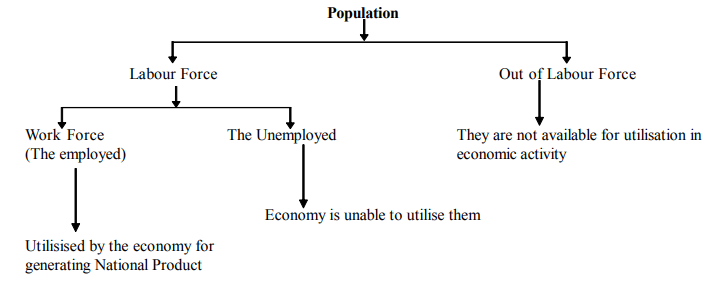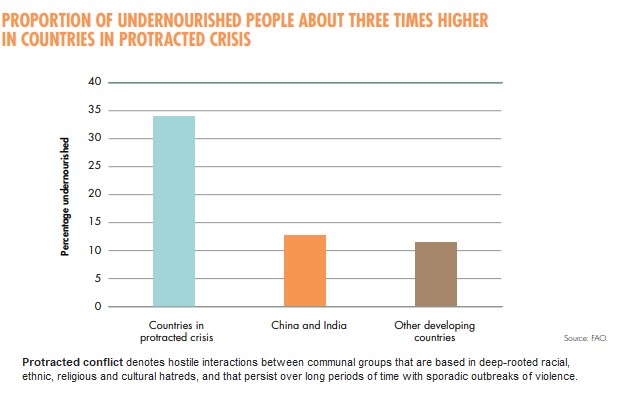18 Dec
COP26
Introduction: A brief history of Environmental and climate negotiations
- At the start of the 20th century, climate change was largely seen as an esoteric study into a theoretical scientific phenomenon. In the latter half of the 20th century, environmental issues entered the international and intergovernmental arena for the first time.
- In 1972, the first international environmental summit took place in Stockholm, Sweden. It led both to the creation of the United Nations Environment Programme (UNEP) and to commitments to coordinate global efforts to promote sustainability and safeguard the natural environment.
- In 1987 the UN General Assembly adopted the Environmental Perspective to the Year 2000 and Beyond - a framework to guide national action and international cooperation on policies and programmes aimed at achieving environmentally sound development. The Perspective underlined the relationship between environment and development and for the first time introduced the notion of sustainable development.
- In 1988, Intergovernmental Panel on Climate Change (IPCC) was established which produced itsfirst assessment report in 1990. Building on the momentum generated by the IPCC reports, negotiations on what became the UN Framework Convention on Climate Change (UNFCCC) were launched by the UN General Assembly. The Convention was adopted in 1992 and opened for signatures at the UN Conference on Environment and Development (the Earth Summit) in Rio de Janeiro, Brazil.
- This was the first global agreement on climate change and has near universal membership with 197 Parties. The objective of the Treaty is to: “stabilize greenhouse gas concentrations in the atmosphere at a level that would prevent dangerous anthropogenic interference with the climate system.”
- UNFCCC was the first global agreement that acknowledged the existence of human-induced climate change.
- “Common but differentiated responsibilities” (CBDR) is one of the main principles of the Convention. It is very relevant in the negotiations and is also known as "differentiation". The principle implies that, although all countries are responsible for creating climate change, some are more responsible than others.
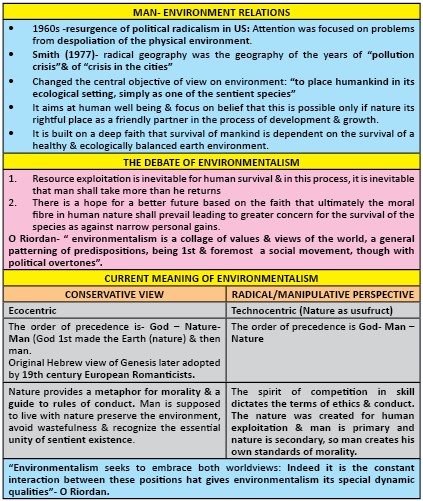
- There have been 25 meetings of the Conference of Parties to the UNFCCC (COP) till 2020. The Glasgow meeting was the 26th session of the COP, or COP26. These meetings are held every year to construct a global response to climate change. Each of these meetings produces a set of decisions which are given different names. In the current case, this has been called the Glasgow Climate Pact.
- Earlier, these meetings have also delivered two treaty-like international agreements, the Kyoto Protocol in 1997 and the Paris Agreement in 2015, which form the global architecture for actions to be taken to tackle climate change. While the Kyoto Protocol expired in 2020, the Paris Agreement is now the active instrument to fight climate change.

Important Issues at CoP26 –The Agenda
What did we need to achieve at COP26?
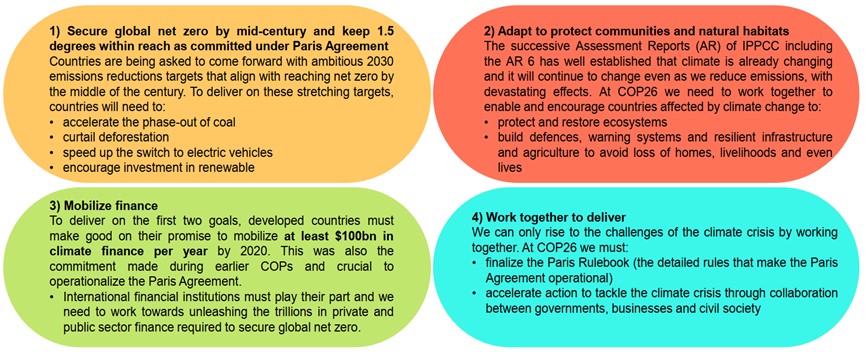
COP26 Outcomes
What happened at COP26?
- Decisions in Glasgow fall under the three UN climate treaties: the United Nations Framework Convention on Climate Change (the COP), the Kyoto Protocol (the Conference of the Parties serving as the meeting of the Parties to the Kyoto Protocol (CMP)), and the Paris Agreement (the Conference of the Parties serving as the meeting of the Parties to the Paris Agreement (CMA)). The Glasgow Climate Pact is manifested across all three.
- The Glasgow Climate Pact preambleconfirms the centrality of a sustainable recovery from Covid-19 and solidarity with vulnerable parties to global efforts to tackle climate change. It also reaffirmed the continuation of key principles from the Paris Agreement and previous COPs, including multilateralism, and the importance of nature and biodiversity to climate action, as well as human rights, the rights of indigenous peoples, local communities, migrants, children, persons with disabilities and people in vulnerable situations, gender equality, empowerment of women and intergenerational equity.
Key Outcomes of COP26


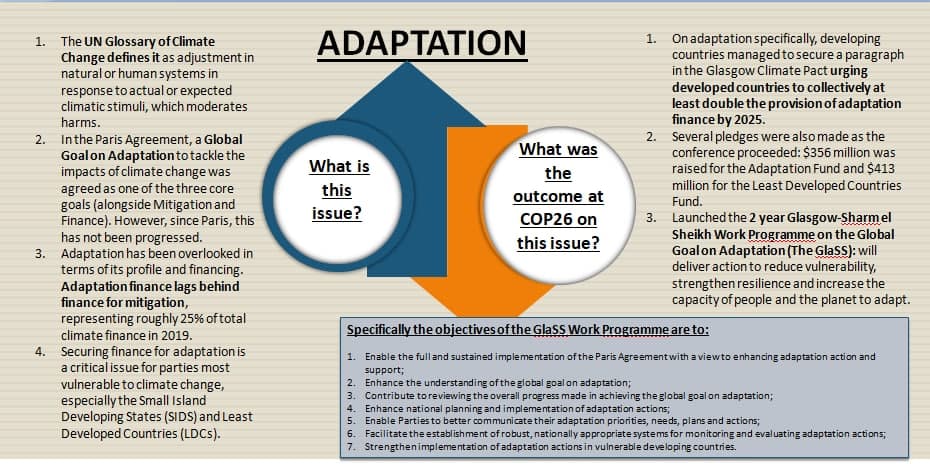

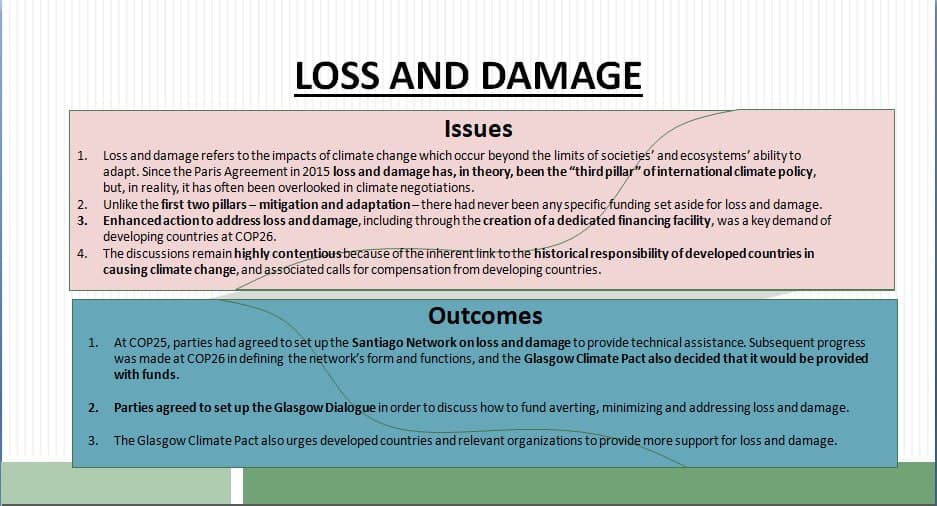
|
5) The Paris Rulebook |
|
|
The Paris Agreement sets out goals, targets and principles, but without details on how to achieve them. Shortly after COP21, governments began negotiating rules governing the implementation of the agreement – termed the ‘Paris Rulebook’. While most of the rulebook was agreed in 2018, several issues were unresolved – most notably the rules governing international carbon markets (anticipated in Article 6), common time frames for NDCs, and transparency. |
|
|
Article 6 |
What is this issue?
|
|
Common Time Frames |
What is this issue?
What was the outcome at COP26 on this issue?
|
|
Enhanced Transparency Framework |
What is this issue?
What was the outcome at COP26 on this issue?
|
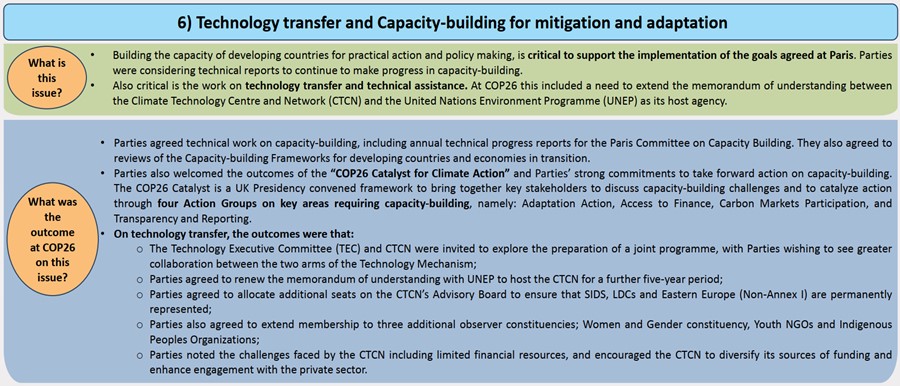

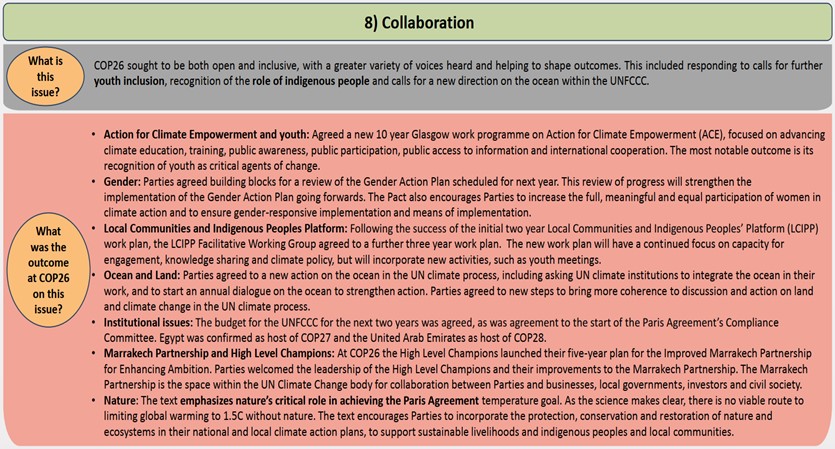
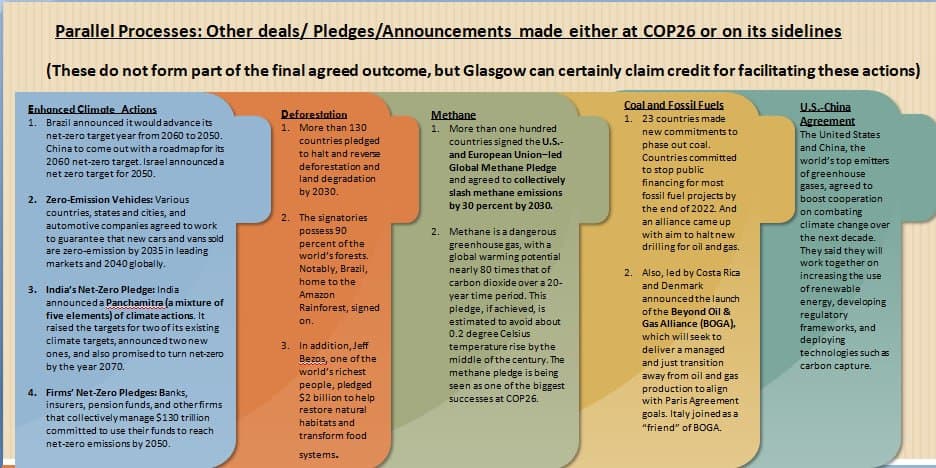
India at COP 26

India’s climate promises and how far India is on track to meet them
|
Net-zero |
Of the five-point targets announced by India, achieving net-zero emission status by 2070 is the one whose roadmap is not available right now. This promise seems to have been made primarily to satisfy the international demand. At the same time, 2070 is a long way away — and there is plenty of time to plan a roadmap to achieve that target. The other four targets have to be achieved in a more immediate timeframe, by 2030.
|
|
Emission intensity
|
|
|
Forest cover: Not addressed |
|
|
Renewable Matrix
|
|
|
Absolute emissions
|
|
|
The Road ahead for India |
|
|
|
Major Gaps that remain post COP 26
Below, we take a look at the major gaps in international progress on climate change going into COP26, and where they stand now.
- Weak 2030 targets
- The goal of the Paris Agreement is to limit global temperature rise to well below 2℃ this century, and to pursue efforts to limit warming to 1.5℃. Catastrophic impacts will be unleashed beyond this point, such as sea level rise and more intense and frequent natural disasters.
- But new projections from Climate Action Tracker show even if all COP26 pledges are met, the planet is on track to warm by 2.1℃ – or 2.4℃ if only 2030 targets are met.
- Technically, the 1.5℃ limit is still within reach because, under the Glasgow pact, countries are asked to update their 2030 targets in a year’s time. However, “the pulse of 1.5℃ is weak”.
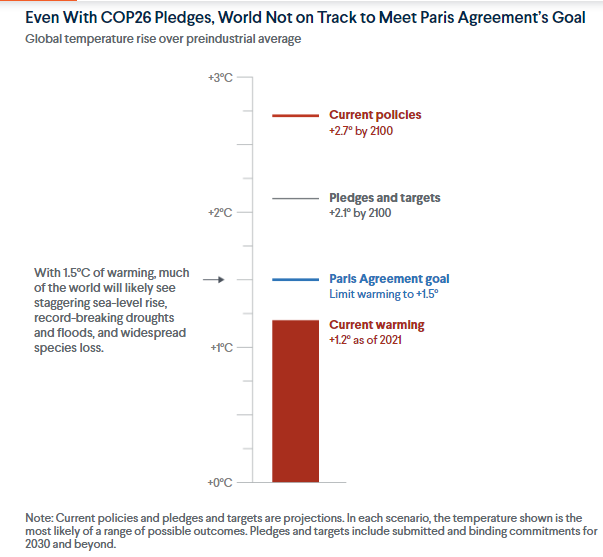
- Phase down, not out
- Instead of phase out, the countries agreed too much weaker commitment to phase down the fossil fuel based energy production. Despite the historic call in the Glasgow Climate Pact for a “phase-down” in coal power, some coal-reliant countries have indicated that they will not completely stop using coal until the 2040s or later.
- Moreover, under the rules for global carbon trading (under Article 6), the fossil fuel industry will be allowed to “offset” its carbon emissions and carry on polluting. Combined with the “phasing down” change, this will see fossil fuel emissions continue.
- Climate finance
- The $100 billion that industrialized countries are supposed to provide annually for developing countries from 2020 on, will not be reached until 2023. Countries from the Global South called that fraud. This breach of trust clouded further negotiations on a new financial target for the period after 2025. The African Group insisted on a sum of between at least $750 billion and $1.3 trillion, while the industrialized countries remained silent on the figure to be targeted.
- Although the Adaptation Fund, which was established in 2001 to finance adaptation efforts in developing countries, received $356 million in new support at COP26, funding levels remain woefully inadequate. And though the pact presses rich nations to at least double finance for adaptation by 2025, this remains billions of dollars below the projected costs.
- Disappointment over Loss & Damage (L&D)
- Nations failed to agree on whether to create a “loss and damage” fund, a kind of insurance policy that would compensate climate-vulnerable countries for damage resulting from emissions that they did not create.
- Instead, the pact includes a promise for future dialogueabout increased financial support and technical assistance to mitigate climate-related damage.
- Civil society observers called the outcome a "betrayal" of millions of people already suffering from climate change. Developing countries expressed "extreme disappointment" that no clear plan for future financing of loss and damage was agreed.
- Interests of developing countries negated
- From the perspective of developing countries, which are hard hit by climate change, the pledges and actions are inadequate. The damage and consequences of climate change and urgently needed adaptation measures, and the development of renewable energy structures is insufficiently supported.
- The concept of climate justice
- Climate change is about the past, the present and about the future. We cannot erase the fact that certain countries (the US, EU-27, UK, Canada, Australia, Japan and Russia, and now China) have consumed roughly 70% of the carbon budget — the space in the atmosphere that is available to limit the temperature rise to 1.5°C.
- But some 70% of the world’s people still need the right to development. As these countries grow, they will add emissions and take the world to catastrophic levels of temperature rise. It is for this reason climate justice is not an add-on concept for some, but the pre-requisite for an effective and ambitious agreement.
- The disagreements over adaptation funds, L&D funds etc shows the lack of developed nations in agreeing to the CBDR-RC principle of UNFCCC which is meant to promote climate justice.
- Ignored opportunity to integrate the ocean into the climate agenda
- Covering about 72% of the planet’s surface and miles deep, the ocean is the world’s largest and most productive bioreactor. Since industrialization, it has absorbed most of the excess heat and carbon dioxide from burning fossil fuels: were it not for the ocean, most of the earth would already be uninhabitable for humans. The ocean is sick—or angry, as they say in coastal communities, angry with excess energy as well as increasingly acidic.
- Inclusivity issue
- The COP meeting drew criticism that many representatives of different non-governmental groups — including researchers — were prevented from observing the discussions.
- There were nearly 12,000 such representatives categorized into nine constituencies, such as business, young people and researchers. For much of the conference only one representative from each constituency was allowed to observe negotiations inside the rooms. At previous COP summits many more observers have been permitted.
Looking Ahead
- If there is to be any chance of averting the most disastrous impacts of climate change, it is vital that governments now go on to strengthen their NDCs ahead of COP27, and begin putting in place robust policies and regulatory frameworks to drive implementation.
- It is also crucial that the implementation of pledges made outside the formal remits of the UNFCCC – like those on reducing deforestation and phasing out various types of fossil fuels – is monitored. Delivery, implementation and accountability are key.
- From the perspectives of developing countries, and for many civil society representatives, sufficient trust has not been generated to create global solidarity, particularly around financial flows for adaptation and for loss and damage. These issues will only increase in importance, and much more will need to be done to address the very substantial needs of climate-vulnerable countries.
- The next 12 months will see the completion of Sixth Assessment Reports (AR6) of the Intergovernmental Panel on Climate Change, with the Synthesis Report expected to be released ahead of COP27. The contributions to AR6 are expected to further detail the impacts, mitigation efforts and adaption needs of climate change, and give further evidence of the need to accelerate action in all these areas.
Annexure- I: A Timeline of All the COPs
|
Conference of the Parties (COP) |
|
|
COP 1 1995: Berlin, Germany |
It voiced concerns about the adequacy of countries’ abilities to meet commitments under the Body for Scientific and Technological Advice (BSTA) and the Subsidiary Body for Implementation (SBI). |
|
COP 2 1996: Geneva, Switzerland |
Several scientific assessments were carried out like consideration of the second assessment report of the IPCC and the economic and social dimensions of climate change. |
|
COP 3 1997: Kyoto, Japan |
Parties to the FCCC adopted the Kyoto Protocol- included Joint Implementation, Clean Development Mechanisms (CDM) and Emissions Trading. |
|
COP 4 1998: Buenos Aires, Argentina |
Parties adopted a 2-year “Plan of Action” to advance efforts and to devise mechanisms for implementing the Kyoto Protocol |
|
COP 5 1999: Bonn, Germany |
Negotiations centered on enabling decisions for completing the outstanding details of the 1997 Kyoto Protocol. |
|
COP 6 2001: Bonn, Germany |
The agreements included the “flexibility mechanisms” including emissions trading, joint implementation (JI) and the Clean Development Mechanism (CDM). Also led to establishment of three new funds (1) a fund for climate change (2) a least-developed-country fund ) a Kyoto Protocol adaptation fund. |
|
COP 7 2001: Marrakech, Morocco |
The guidelines for flexible mechanisms of joint implementation, CDM markets, emissions trading was agreed upon. It came to be known as the Marrakesh Accord. |
|
COP 8 2002: New Delhi, India |
Emphasised on adaptation measures and stressed that poverty alleviation and development were the utmost priority of developing countries. |
|
COP 9: 2003, Milan, Italy |
The parties agreed to use the Adaptation Fund. |
|
COP 10 2004: Buenos Aires, Argentina |
To promote developing countries better adapt to climate change, the Buenos Aires Plan of Action was adopted. |
|
COP 11 2005: Montreal, Canada |
Meeting of the Parties to the Kyoto Protocol (CMP 1). The event marked the entry into force of the Kyoto Protocol. The Montreal Action Plan was an agreement to extend the life of the Kyoto Protocol beyond its 2012 expiration date. |
|
COP 12 2006: Nairobi, Kenya |
The parties adopted a five-year plan of work to support climate change adaptation by developing countries. |
|
COP 13 2007: Bali, Indonesia |
Agreement on a timeline and structured negotiation on the post-2012 framework was achieved with the adoption of the Bali Action. |
|
COP 14 2008, Poznan Poland |
Principles for the financing to help the poorest nations cope with climate change and a mechanism to incorporate forest protection into the efforts. The Poznan Strategic Programme on Technology Transfer. |
|
COP 15 2009: Copenhagen, Denmark |
Copenhagen Accord drafted. Developed countries pledge up to USD 30 billion in fast-start finance for the period 2010-2012. |
|
COP 16 2010: Cancún, Mexico |
The outcome of the summit was an agreement adopted by the states’ parties that called for the US$100 billion per annum “Green Climate Fund”, and a “Climate Technology Centre” and network. |
|
COP 17 2011, Durban, South Africa |
Negotiations on a legally binding deal comprising all countries, to be adopted in 2015, governing the period post 2020. |
|
COP 18 2012, Doha, Qatar |
The Doha Climate Gateway contained: The Doha Amendment to the Kyoto Protocol. COP18 also launched a second commitment period of the Kyoto Protocol. |
|
COP 19 2013, Warsaw, Poland |
The term Intended Nationally Determined Contributions was coined in Warsaw.The Warsaw Framework for REDD Plus and the Warsaw International Mechanism for Loss and Damage. |
|
COP 20 2014, Lima, Peru |
An agreement was reached in which all countries will specify their objectives under INDC. |
|
COP 21 2015, Paris, France |
Negotiations resulted in the adoption of the Paris Agreement on governing climate change reduction measures from 2020. |
|
COP 22 2016, Marrakech, Morocco |
The conference incorporated the twelfth meeting of the parties to the Kyoto Protocol (CMP12), and the first meeting of the parties to the Paris Agreement (CMA1). A focal issue of COP 22 was that of water scarcity, water cleanliness, and water-related sustainability, a major problem in the developing world. |
|
COP 23 2017, Bonn, Germany |
‘Fiji Momentum for Implementation,’ which outlined the steps that need to be taken in 2018 to make the Paris Agreement operational and launched the Talanoa Dialogue. |
|
COP 24 2018, Katowice, Poland |
The conference agreed on rules to implement the Paris Agreement. |
|
COP 25 2019, Madrid, Spain |
Ended without any outcome on the creation of a system of credits for reduction of emissions. Passed Chile-Madrid Time for Action" declaration. |
Tropical Forest Alliance (TFA)
- Why in news: The FACT (Forest, Agriculture and Commodity Trade) Dialogue is hosted by the COP26 Presidency and supported by the TFA, to accelerate the transition towards more sustainable land-use practices
- The Tropical Forest Alliance (TFA) 2020 was founded in 2012 at Rio+20 after the Consumer Goods Forum (CGF) committed in 2010 to zero net deforestation for palm oil, soy, beef, and pulp and paper supply chains by 2020.
- Objectives: 1) To mobilize and coordinate actions by governments, the private sector and civil society to reduce tropical deforestation related to key agricultural commodities by 2020. 2) To realize sustainable rural development and better growth opportunities based on reduced deforestation in tropical forest countries.
- TFA is funded by the governments of Norway, the United Kingdom and the Netherlands. Its secretariat is hosted at the World Economic Forum.
- Famous initiatives by TFA: Marrakesh Declaration for the Sustainable Development of the Oil Palm Sector in Africa in 2016, TFA 2020 Colombia Alliance and Peatland Restoration initiative in Indonesia.
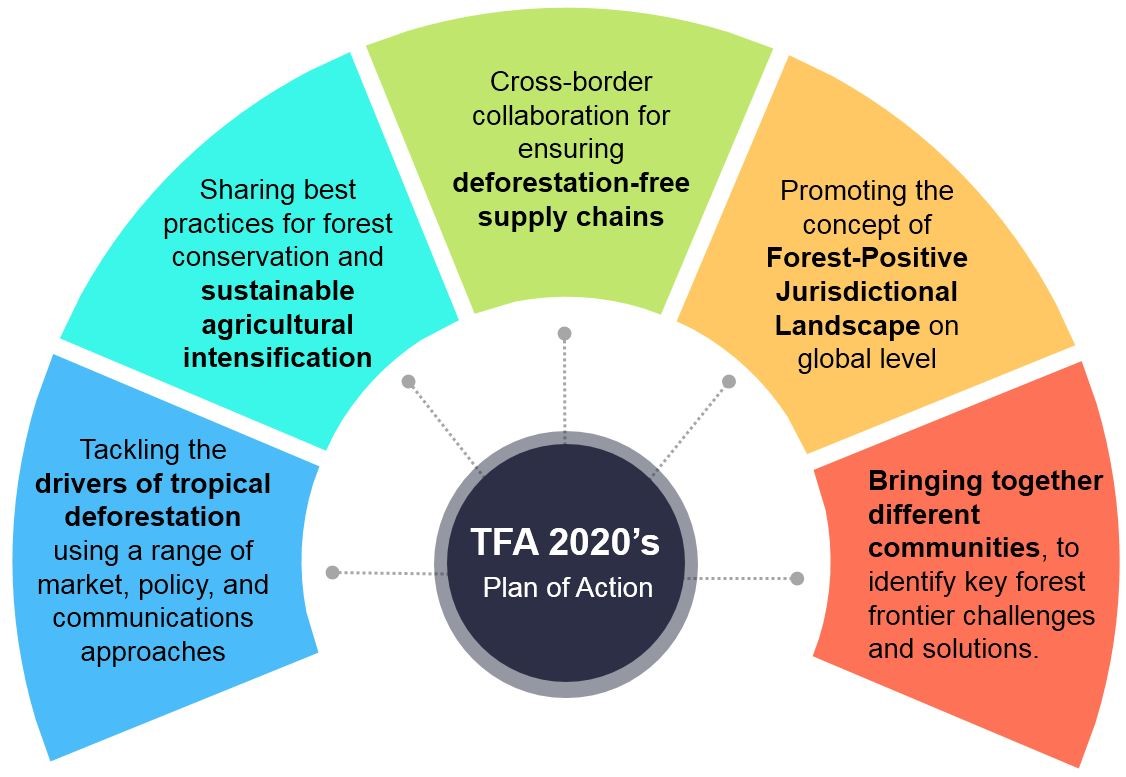
Source:
Infrastructure for Resilient Island States (IRIS)
- Why in news: PM Modi has launched the IRIS initiative at COP 26, saying ‘it will give a new hope, a new confidence and satisfaction of doing something for the most vulnerable countries facing the biggest threat from climate change.
- Objective: IRIS aims to support Small Island Developing States (SIDS) in achieving sustainable development with a systematic approach to resilient, sustainable, and inclusive infrastructure through technical support, knowledge sharing, partnerships and technical collaborations.
- Need for IRIS: SIDS are the most vulnerable regions to climate change on the earth. Every infrastructure of SIDS is extremely critical to them. Hence, their infrastructure should be climate proofed and resilient to disasters.
- IRIS will be a part of the India-UK Coalition for Disaster Resilient infrastructure (CDRI). CDRI was launched by PM Modi at the 2019 UN Climate Action Summit & it is an international coalition of countries, UN agencies, multilateral development banks, the private sector etc. that aim to promote disaster-resilient infrastructure.
- IRIS will be implemented from 2022 to 2030 in 58 countries located across the Caribbean, Pacific, Atlantic, Indian Ocean, Mediterranean and South China Sea regions.
- IRIS is much along the lines of SAMOA Pathway (SIDS Accelerated Modalities of Action), 2014 which is working towards the sustainable development of SIDS through genuine and durable partnerships.

Sources:
One Sun, One World, One Grid (OSOWOG)
- Why in news: OSOWOG was jointly released by PM Modi and UK Prime Minister Boris Johnson at the COP26, Glasgow.
- OSOWOG brings together the International Solar Alliance and the UK’s green grid initiative and complements India’s focus on harnessing the sun’s energy.
- The vision behind the OSOWOG is ‘The Sun Never Sets’ and is a constant at some geographical location, globally, at any given point of time.
- Aim: It targets to interconnect solar energy infrastructure under the initiative of trans-national electricity grids that will be developed to deliver solar power.
- Significance: With OSOWOG we can access clean energy at all places, it will address the issue of reliability of supply from solar power plants (which do not operate after the sun has set) by utilizing the day-night gaps between the countries, it will also address the issue of high cost of energy storage which in effect will reduce the costs of the energy transition.
- Challenges: Requires huge capital investments for setting up trans-national grids, geopolitical implications and the mechanism of cost-sharing will also be challenging as participating countries are both rich and poor nations.
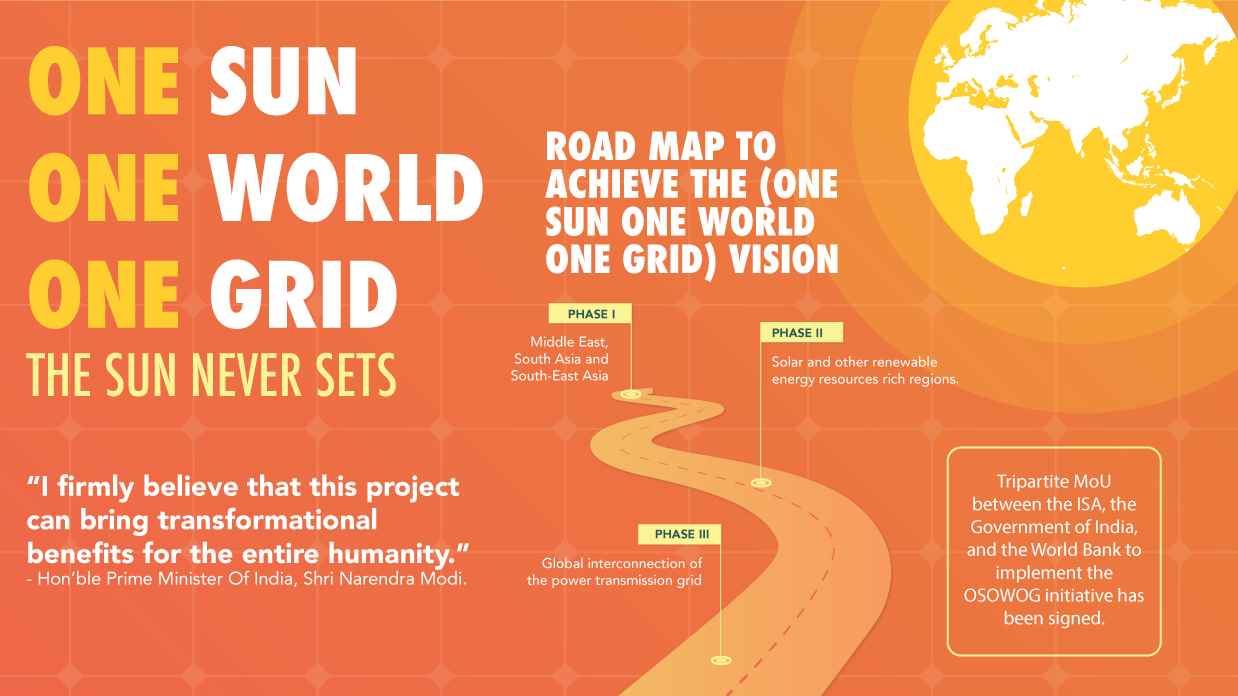
Sources:
Adaptation Fund
The Adaptation Fund was established to finance concrete adaptation projects and programmes in developing countries that are parties to the Kyoto Protocol and are particularly vulnerable to the adverse effects of climate change.
Since 2010, the Adaptation Fund has committed more than US$ 850 million for climate change adaptation and resilience projects and programmes, including more than 123 concrete, localized projects in the most vulnerable communities of developing countries around the world with 28 million total beneficiaries.

Adaptation Fund Strategic Pillars and cross cutting themes
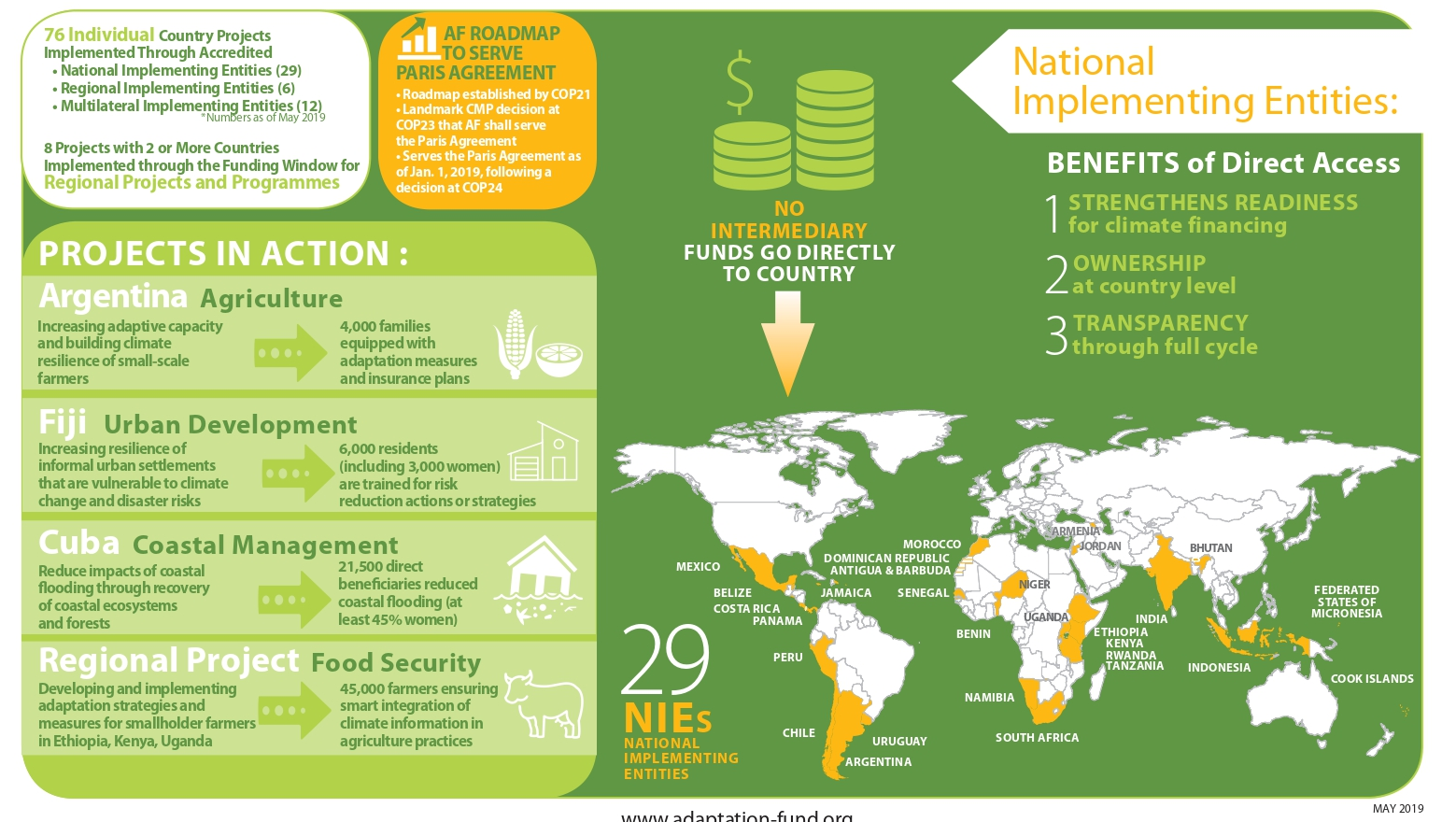
It also pioneered Direct Access, empowering countries to access funding and develop projects directly through accredited national implementing entities.
Sources:
Decarbonizing the Transportation Sector- United Kingdom (UK)
Context: COP 26 was the first climate conference to emphasize the benefits of accelerating zero emissions transportation and Drive Electric partners showed up in full force.
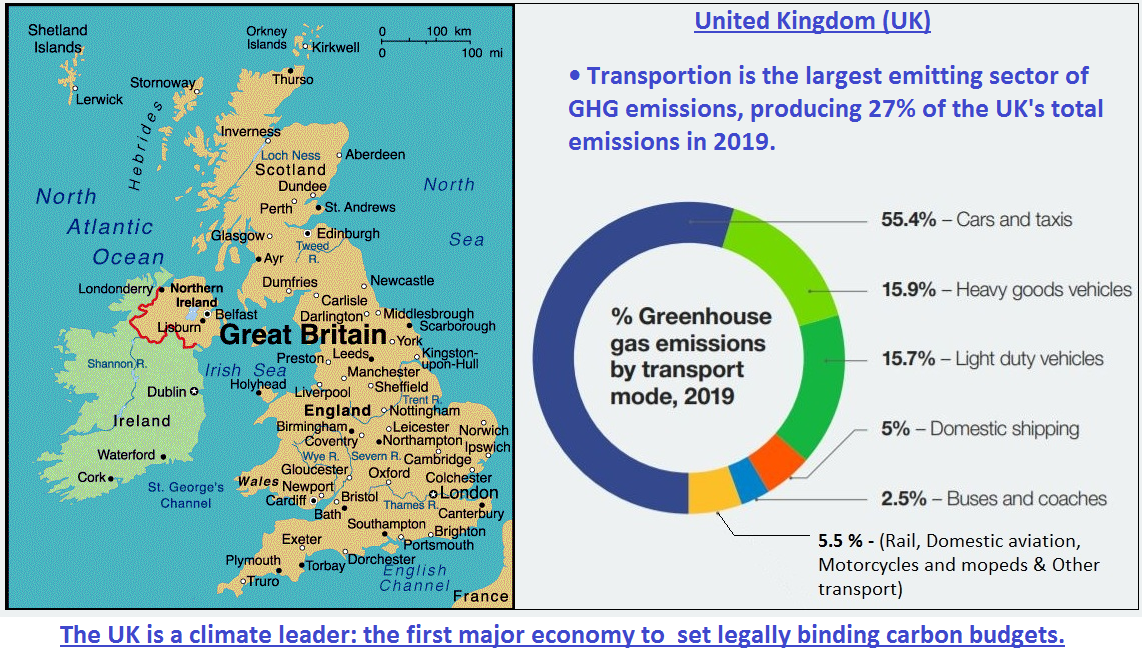
Several initiatives taken by United Kingdom to decarbonize its transportation sector:
- In July 2021, UK government- first in the world- announced its Transport Decarbonisation Plan, a blueprint to reduce the transport sector’s CO2 emissions to net-zero. It is highly ambitious and a holistic strategy that covers almost all modes of transportation. It includes the following:

- In January 2021, UK unveiled a national electrically-assisted bike subsidy programme- If as much car travel as possible is replaced with E-bikes, this could save up to 30 million tonnes of carbon emission per year, equivalent to 50% of current CO2 emissions from cars.
- Clean air day campaign, 2018: UK’s largest annual air campaign in a day of mass public engagement, including an information portal, face-to-face activities, press and social media.
Benefits from decarbonisation of transportation sector:

This can be replicated in cities of India, where transportation is the third most CO2 emitting sector (IEA, 2020).
Where it can be used?
It can be used in topics related to Paper 1 (Climate Change, Sustainable development of cities, Problems of Urbanization), Paper 2 (Urbanization, Sustainable Growth) and GS 1 (Urbanization).
Sources:
Places in news
|
Aravalli
|
|
Osmanabad
|
|
Daringbadi
|
|
Anantapur
|
|
Kulum Village
|
|
Haiderpur wetland
|

Share the article
Get Latest Updates on Offers, Event dates, and free Mentorship sessions.

Get in touch with our Expert Academic Counsellors 👋
FAQs
Geography Current Affairs focuses on the contemporary issues, events, and developments in the field of geography. It covers recent geographical phenomena, environmental changes, geopolitical shifts, and related news. This differs from regular geography studies which may focus more on foundational concepts, historical contexts, and theoretical frameworks.
Updates are provided regularly to ensure that subscribers stay informed about the latest developments in geography. Typically, updates are provided on a fortnightly basis, depending on the frequency of significant events and changes in the field.
Absolutely. Geography Current Affairs serves as a valuable resource not only for Geography optional but also for GS papers, especially GS Paper 1 (covering Indian Heritage and Culture, History, and Geography of the World and Society) and GS Paper 3 (covering Technology, Economic Development, Biodiversity, Environment, Security, and Disaster Management). It aids in building a holistic understanding of various topics and strengthens answer-writing skills by incorporating contemporary examples and perspectives.
Geography Current Affairs holds immense importance for UPSC preparation, particularly for aspirants opting for Geography optional. It helps candidates stay updated with the latest developments, geographical phenomena, environmental issues, and geopolitical shifts worldwide, aligning them with the dynamic nature of the subject as tested in the UPSC examinations.


